Use controls above or click here to open this Hometown Heroes podcast in a new window
100-year-old Geb Galle of Moses Lake, WA appears on episode #708 of Hometown Heroes, airing November 20-22, 2021. Born in Germany and raised in North Dakota, Galle spent 6 years in the U.S. Navy and experienced the majority of World War II’s Pacific battles aboard three different distinguished vessels.
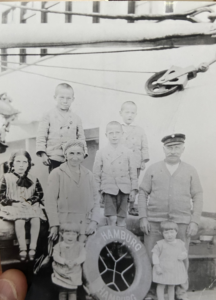
You’ll hear Galle’s childhood memories, growing up on a 15-acre farm in Germany, where he remembers eating cherries straight from the tree. His father had been a medic in the German Army in World War I, and Geb understands that if his family hadn’t come to America in 1928, he and his siblings might have had a very different future.
“I probably wouldn’t be here (alive) now, If I had stayed over there,” you’ll hear Galle explain. “I’m very happy that we came to this country, and I was very happy to be able to serve this country.”
The family came to Saint Thomas, ND, eventually settling on a farm about ten miles north of town. Geb and his siblings started to learn English at their country school, enlisting a local German butcher for help on vocabulary. That school only went to eighth grade, and economic and weather realities prevented him from being able to make that ten mile commute into Saint Thomas for high school. You’ll hear Geb’s memories from the Great Depression era, the extra things his family did to get by, and also what led to Geb’s decision to enlist in the Navy after he turned 18.
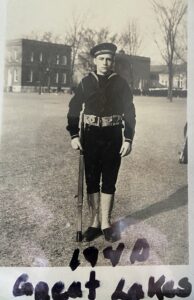
His enlistment was for six years, but little did Geb know how action-packed those six years would be as he completed boot camp at Great Lakes Naval Training Station before heading out to San Pedro, CA, where he joined the crew of the battleship USS Nevada (BB-36). The Nevada headed to Pearl Harbor, where the battleship would soon be participating in fleet engagement exercises, simulating what activities may be necessary if the United States were ever at war. After starting out on the deck force, Geb worked his way into an assignment to the engineering division’s refrigeration and air conditioning department. His Navy service would earn him U.S. citizenship, while also leaving him with scores of memories from some of World War II’s most famous engagements, starting with Imperial Japan’s attack on Oahu on December 7, 1941.
“I had my whites on, and I was ready to go ashore, and I was gonna go to church,” you’ll hear Galle recall. “I happened to look out the porthole, and I noticed some planes were flying around, but I didn’t pay any attention to the insignia on them.”
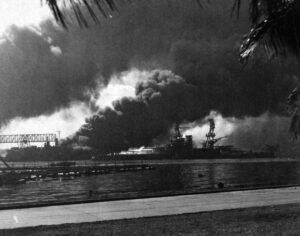
Like so many others in Pearl Harbor that day, Galle initially assumed the aircraft were American. His first indication that they were actually enemy planes came with a memorable encounter below deck. The Nevada’s band had been performing on the battleship’s fantail for the raising of the colors. Geb soon saw frantic bandsmen hustling down below.
“They came running down with their drums and instruments,” Galle remembers, alarmed by what they hollered next: “Man your battle stations.”
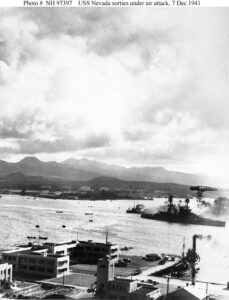
Still presuming it was an exercise, and an inconvenient one at that, he descended two more decks to his duty station in the refrigeration room. When he felt the vibrations of the battleship’s 5-inch guns firing above, he started to wonder, and soon came verbal confirmation that the ship was under attack. From its mooring alongside the ill-fated USS Arizona, the Nevada got underway, receiving multiple blows as it headed down the channel.
“We knew we got hit with something,” Galle says of the feeling below deck, blind to the visuals above. “And of course we got hit with a couple of bombs, and of course, torpedoes.”
A torpedo struck the Nevada at 8:10 a.m. that Sunday morning. Later on, while trying to maneuver out of the harbor, the ship was attacked by Japanese dive bombers as part of the enemy’s second wave, with five bombs striking the battleship, threatening to sink it in a position that would block the channel and trap other ships inside the harbor.
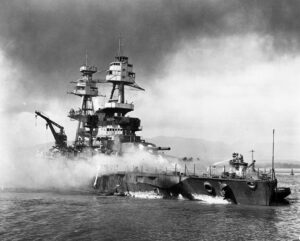
You’ll hear Galle explain what those intense moments felt like three decks down on the damaged battleship, which was run aground at Hospital Point in order to keep the channel open. 60 of Geb’s shipmates were killed that morning, more than 100 more wounded.
“Your eyes are going wild,” Galle says of the sensory overload of taking in the scene. “By the time we got up topside, practically all of the fires were put out, but there was quite a bit of smoke.”
75 years later, Galle had the privilege of setting a commemorative plaque at the spot where the Nevada ran aground, as detailed in this piece from the Las Vegas Review Journal.
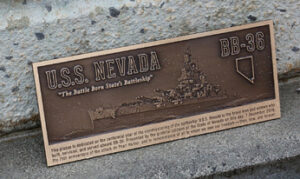
While the Nevada would be under repair for the next ten months, it was only a matter of days until 20-year-old Geb Galle was reassigned to the heavy cruiser USS Northampton (CA-26), part of the task force headed by the carrier USS Enterprise. You’ll hear Geb’s recollections from watching B-25s take off from the carrier USS Hornet as the Doolittle Raid was launched in April, 1942. Six weeks later, his ship participated in the Battle of Midway. When the Hornet was hit in the Battle of the Santa Cruz Islands that October, it was the Northampton that took the Hornet into tow, until that became too dangerous. Geb remembers his ship picking up some survivors of the Hornet’s sinking. A little more than a month later, it was the Northampton that would be sunk. On November 30, 1942, during the Battle of Tassafaronga, the cruiser was struck by two enemy torpedoes.
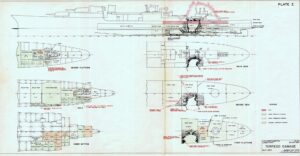
Galle felt the jolt down below in the refrigeration room, and all the lights went out. Soon, emergency lighting powered on, and the now 21-year-old sailor tried his best to navigate a chaotic situation. You’ll hear him explain how he was about to open a hatch to the steering compartment when he was ordered by an officer not to do so. Having been in that compartment before, Geb knew the men on the other side of that hatch would go down with the ship if he didn’t open it.
“When he left, I went up on topside and couldn’t see him anymore,” he says of that officer. “I went and opened up the hatch.”
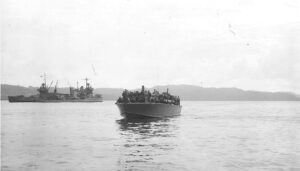
Geb’s decision to disobey that direct order resulted in four sailors’ lives being saved, but while most of the Northampton’s crew was rescued that night, Galle would spend the next two days floating on a raft. You’ll hear his memories from those two difficult days, and what it felt like when the survivors were finally rescued by a PT boat that would become quite well known in the years that followed, PT-109.
“You know in your own mind what you’re gonna have to do to survive,” you’ll hear him recall of that ordeal. “To keep your nose above that water.”
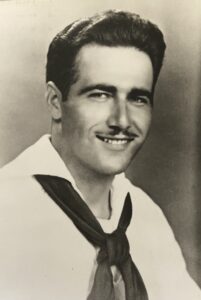
A thirty day survivor’s leave allowed him to go home for the first time since he had joined the Navy. When those thirty days were up, Geb was assigned to the light cruiser USS Mobile (CL-63), which supported most of the major landings in the Pacific over the years that followed. His six-year enlistment didn’t expire until after the Japanese had surrendered. The totality of what he lived through during World War II lends powerful perspective to his family, which included five children, 13 grandchildren, and now a growing number of great-grandchildren. When asked to what – or whom – he attributed his survival, Galle pointed heavenward.
“You gotta have faith,” you’ll hear this centenarian say. “That’s all it takes.”
Watch the video below for a taste of how sharp and spirited Geb remains at age 100.
—Paul Loeffler
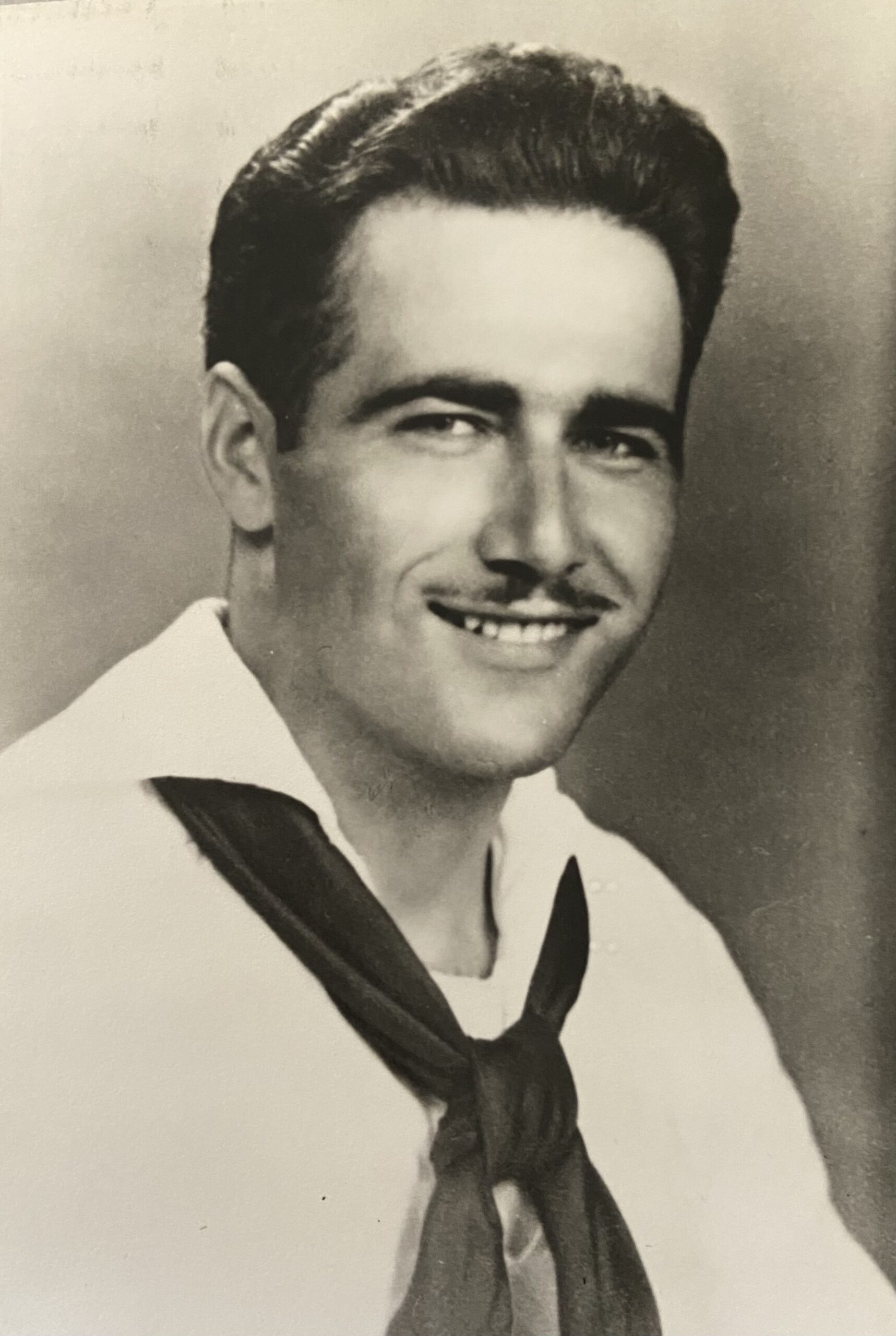


Leave a Reply